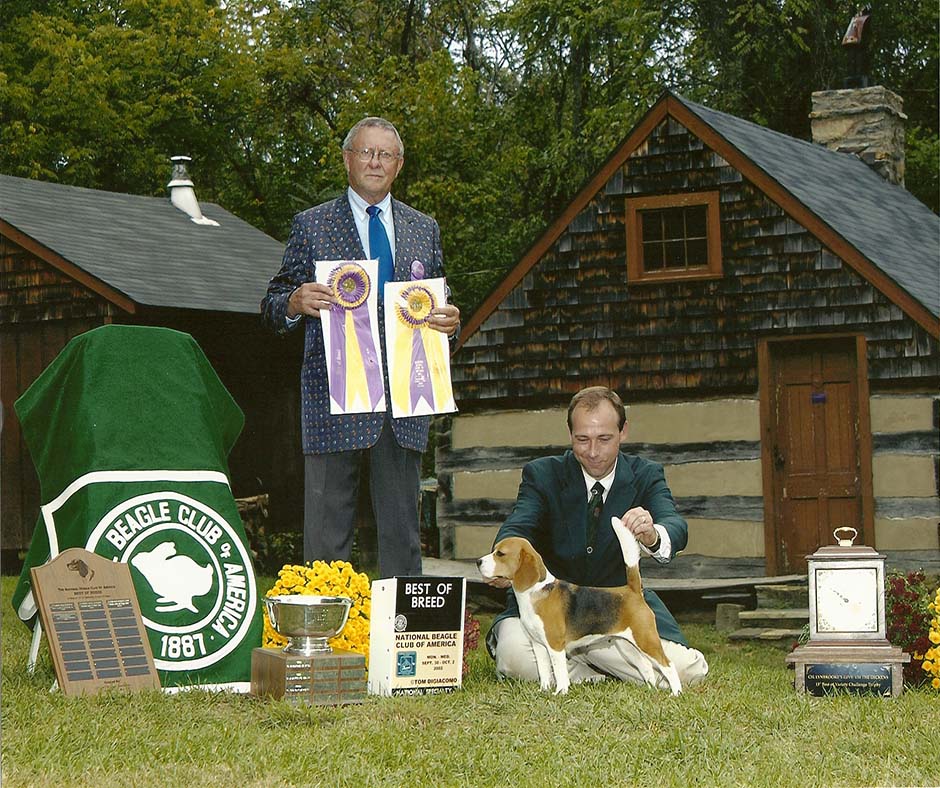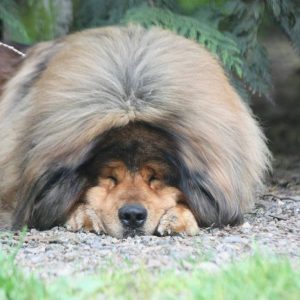183 — Solving the Mysteries of AKC Points and Divisions

Solving the Mysteries of AKC Points and Divisions
AKC releases a new point schedule every year in May to determine how many entries it takes to earn championship points in each breed. Intermittently, the “divisions” that address alignment of regions in which certain point schedules apply are adjusted as well. On May 16 this year, the new points schedule and a division realignment go into effect.
Alan Slay, AKC Director of Event Programs, is here to walk us through the process involved in determining what “makes a major” in every single breed and sex and region of the country each year.
Computers to the Rescue
Fortunately, computers do most of the hard work, Slay said. But the basic formula has remained the same since at least 1971, the oldest documentation he could find.
“So a software program goes and looks at each division, breed and sex,” Slay said. “… 15 Divisions, each breed, each of the sexes, you do that math, that’s a lot of looking. (It) individually looks at the shows that had competitors and then it sorts them and then uses those guidelines set by the board of directors to determine what the number of competitors should be required for each of those one, two, three, four and five points.”
The AKC Board of Directors’ guidelines, according to Slay, are that 95 percent of shows should have one point available, 18 percent of shows should have at least a three-point major on offer and 2 percent of shows should have a five-point major in each division, breed and sex.
Nationals NOT Included in Calculations
Slay noted that Parent Club National Specialties are NOT included in these calculations. He added that more recently ANY show within three days and 50 miles of a National Specialty also is not included in these averages.
“Myself and others working on this saw some disparity of almost a penalty for allowing a National Specialty to come into your division the way the formulation used to work,” Slay said. “About four years ago, we went to the Board of Directors and said this is just not fair. For instance, you have a national specialty occurring on a Thursday, maybe Wednesday and Thursday. And you’d have a cluster over the weekend at the same site on Friday, Saturday and Sunday. Well that Friday, Saturday, Sunday for that breed would have an inflated number of competitors compared to what it would normally have. And those all-breed or other specialties were counting toward the point schedule.”
New Divisions Bring Fairness to Exhibitors
Slay and his team also looked at fairness and equal distribution of shows when they created the first realignment of divisions in six years.
“This is an odd-looking division we created with Arizona and Colorado,” Slay said. “ … it would be nice to make a little square there (and) make a division out of Utah, Colorado, Arizona, and New Mexico. But that is not fair to Utah and New Mexico.
“Utah and New Mexico … the people who live in those states would be greatly affected by the competitors in Arizona and Colorado. … it’s the fairest thing we could do because … Utah and New Mexico really belong in that division with Nebraska, New Mexico and Nevada, and South Dakota. They had similar size shows.”
I hope everyone takes a minute to listen to this excellent discussion with Mr. Slay and is able to gain a greater understanding of how our points and divisions are created. There’s no voodoo magic here!
And remember to stick around for Allison Foley’s Tip of the Week from the Leading Edge Dog Show Academy. Today Allison is talking about getting dogs past those things they hate, including toe nail trimming.
To reach Alan Slay on email, go to ALS@AKC.org … To access this information on an interactive PDF, click here AKCConformationPointsSchedulePodcastImages
Pure Dog Talk is the voice of purebred dogs. We talk to the legends of the sport and give you the tips and tools to create an awesome life with your purebred dog. From showing to preservation breeding, from competitive obedience to field work, from agility to therapy dogs, and all the fun in between – your passion is our purpose!
LAURA REEVES: Welcome to pure dog talk. I am your host Laura Reeves and I have a very special guest for us today. Mr. Alan Slay is joining us from the American Kennel Club. Alan is the Director of Event Operations correct, Alan?
ALAN SLAY: Event Programs, but essentially the same.
LR: Event Programs. OK very good. And we’re coming up onto May when the point schedule changes every year – we all wait for it to see whether we’re going to get more or less or how are our majors going to work. And everybody is all excited. And sometimes there’s confusion about how that works and why things go the way they do. So Allen is here to help us understand that and I really appreciate your time.
AS: You’re welcome.
LR: Excellent. OK. So as I was mentioning, point schedules, divisions, all of this – this is very intense interest, right, to those of us that are showing our dogs and we’re always looking for, you know, the best advantage or where can I go to find that major. How does this work. So can you give us some of the sort of critical infrastructure that makes this happen. You’re the guy that does this, this is your baby if you will.
AS: I’m responsible for it yeah, I work closely each year with our technology team. The AKC technology services – ATS. And so there are really two components here. There’s the one is that each year we formulate the point schedule for the following year, and then traditionally about every five years we do an analysis of the composition of the divisions to try to make sure we have a fair and balanced division of states across the different divisions. And it just so happens this year was one of the years – we’d last done it in the point schedules released in 2012. And this year we did that realignment. So I’ll take you through each of those.
LR: That would be amazing!
AS: The overall process and then we can discuss more details and each one of them if you if you would like. Because I’ll make sure I understand how it worsk.
LR: I think it’s wonderful and listeners, just a note, I am still a dog breeder here at Pure Dog Talk and that is a bitty baby puppy you might hear in the background so forgive us. So go ahead Alan. I really think this is important for people to understand.
AS: Sure. So let’s talk about the, just the point schedule we do every year. And that is, our clock for formula that starts somewhere about mid January and because that is the time when we will have processed all the conformation events, the results, from the previous year. So one thing I want to point out is, is that while our point schedule begins usually in May -w e started somewhere on the second or third week of May – we try to pick a date where there are no or few events that for a string there at the point schedule is consistent for the string of events occurring at a site. The point schedule itself is based off the competition that was held in the previous calendar year. And I want to emphasize that is the competition because there are some misconceptions out there that we base it off of the total number of entries or the total number of shows where a breed could compete, or it’s the registration – none of that is true, just based purely off of the dogs that competed within a division, a breed, and a sex the previous year. So that’s what goes into the process for determining that point schedule.
LR: OK
AS: So sometime around the second week of January, once we process the results, what we’ll do is work with the technology services and we have some software programs that have been programmed to reflect the guidelines that have been set by the board of directors as to how to set the points the number of competitors required at the 1/2/3/4/5 point level and for a refresher for folks.
LR: Right cause I think this is new to a lot of people so if we can just kind of break that down just a little bit.
AS: I will and I’ll say that preparing for the talk, I’ve been on the AKC since 1996, so in my 20 years this has always been the same and I did a little research trying to find out, you know, when did this go into effect. As far back as we could find, 1971, and it was in effect then so-…
LR: Wow.
AS: You know it’s been in effect for a long time so there’s nothing new as far as the percentages at each of the point levels.
LR: But what I’m saying is I don’t think people understand that those percentages exist, right? Like, I’ve been in this my entire life and I didn’t know this, so I think this is – I want to put a big bold star around this listeners because this is good information.
AS: Sure. So in each division – I’m gonna read right off some information from our Web site – I think you’re going to include the information you provide associated with the link to this discussion. I’m gonnea read it just right off of that because I think that’s the clearest and easy way to do that. And that is for one point, ninety five percent of the shows where there was competition carry one or more points for dogs and bitches. Each one of these is done separately, each division, breed and sex.
LR: Which can I just say that’s a lot of dogs! That’s a lot of work! I mean you’re talking about 190 breeds, 50 states, 14 divisions and you have to do this for every single one – I just think it’s crazy.
AS: Well that’s what I’m saying, the software program actually has this information and it puts out our first cut of this before we then do some fine tuning to try to make sure that we benefit the exhibitors all that we can. And the way the software works it figures out the one point, the three points. Three points is as close as possible to 18 percent which should not exceed 20 percent of the shows in a division or to carry major points – that’s 3, 4, or 5. And the majors created by best of winners, best of breed, best of opposite, are not counted on this calculation and are effect bonus majors over and above the 18 percent. So the software will determine the one percent – the one point threshold for competitors, the three point threshold, and then the 2 point I said it half the difference between the 1 and 3 Point Break. Then the software begin to calculate the 5 point – the number of competitors required for five points – and that’s as close as possible to 2 percent of the shows already carry 5 points. And then the way we get the 4 point is to get the set at two thirds of the difference between the three and five point break. So a software program goes and looks out for each division, breed and sex. It looks that for each of those are you talking about like you said at each breed the 15 Division each of the sexes so you do that math as a lot of looking individually looks at the shows that had competitors, and then it sorts them and then uses those guidelines set by the board of directors to determine what the number of competitors should be required for each of those the 1/2/3/4/5 points. LR: Right
AS: Now one thing I want to point out is, is that when it’s looking at those shows and I call them candidate – that’s how I refer to them -these are shows that are candidates to be included in the point schedule formulation process. Once again there had to be competition and it was only regular classes. If I had three entries in the record classes and they were all absent, that show itself was not counted in the competition or if there were no issues. So that’s an important aspect there.
LR: And I think it’s important to note because I read this in some of your material, national specialties and regional specialties associated with nationals don’t bump your points schedule up. Is that a correct statement?
AS: It’s actually beyond that. Let me read that – I’d like to extrapolate a little bit …
LR: Yeah, that’d be great.
AS: Let me read here off the web site and then I’ll go a little bit further because it’s even further than what you just said there. Competitions offered by parent clubs are not included in the points schedule, so anything offered by the parent club doesn’t count. And that includes independent specialties as well as designated specialties.
LR: Wow OK.
AS: And this is the part that you were speaking of: Breed competition – notice I said breed competition, and I’ll loop back around that – held by any club, an all breed group or specialty, within plus or minus three days and 50 miles of the breeds parent club National Specialty are excluded from the formulation. Myself and others working on this saw some disparity of almost a penalty for allowing a National Specialty to come into your division the way the formulation used to work. About four years ago, we went to the board of directors and said this is just not fair. For instance you have a national specialty occurring on a Thursday, maybe a Wednesday and a Thursday, and you have a cluster over the weekend the same side on Friday, Saturday, and Sunday – well that Friday/Saturday/Sunday for that breed would have an inflated number of competitors compared to what it would normally have, and those all breed or other specialties were counting toward the point schedule. And so that was almost a penalty for bringing in the national into your division.
LR: Yes.
AS: So we looked at that, we didn’t think that was fair to the exhibitor, and we successfully – the board directors completely agreed. So now we exclude any competitio – it doesn’t matter if it’s held by a local club, a specialty all-breed group, a designated – it doesn’t matter – any competition within plus or minus three days and 50 miles of the National does not count. That also help with things like Montgomery where there’s a lot Natinoals held up there. It took those out of the equation. So actually there are more majors being handed out than just the percentages there. And the last thing I’ll say is is that any events held in conjunction with the AKC National Championship are excluded. So all of the lead up events which is occurring currently in Orlando, even those events are at excluded because once again that would inflate the point schedule, make it more difficult for the rest of that division.
LR: Florida would be in a world of hurt.
AS: So the one thing I do want to point out is one thing when you mention a regional specialty, is there is some misconception out there that we don’t count regional specialties. Well maybe, maybe not. Once again let’s go back to what the board has agreed to there for their guidelines. If that regional specialty is held by the parent club absolutely it is not included in the points schedule formulation. If that regional specialty is held by any club -a local club or a regional club, however the parent club defines it – within plus or minus three days or 50 miles of their national specialty. You only get one National Specialty a year and, you know, some breeds have a National Specialty then a roving. Well they pick which one they want to consider to be their one National per year and that’s what we use. So any one between plus or minus three days or 50 miles, that’s not included. However, if there’s a regional specialty, you know, not within plus or minus three days or 50 miles of a national, and it’s not held by the parent club, those are included in the point schedule formulation.
LR: Right. OK. So I’m just thinking of, for example, this is – and I’m trying to help the listeners understand this and you can clarify if I’m wrong – for example say the Spinone Club of America doesn’t have independent local clubs. And so their parent club hosts regional specialties around different parts of the country and those are not National so those do count for those parts of the country for their point schedules. Is that accurate?
AS: Not if it’s held by the parent club. If it’s on the parent club’s name – no event held under the parent club’s name counts towards the point schedule formulation.
LR: Good. OK, so that’s clear. Nice. Very good. OK. So now we’ve got a handle on that and I think it’s important for exhibitors to understand that 95 percent of the shows are going to have one point and 18 percent of the shows in a division are going to have a three point or a major and only 2 percent of them are supposed to have a five point major – is that – just barebones.
AS: That’s correct. That’s correct. And the software program will then use that algorithm and give us a file of the proposed point schedule. And then we – and I will say this used to be done manually – it’s not anymore.
LR: I bet you’re happy about that, Alan.
AS: Yeah I am. Because you get some blurry eyes looking over here. You get to about that twelfth division and you know you want to treat everybody fairly but it used to be about a two day deal with a door closed. We’ve written a series of database queries that will show us some anomalies. For instance depending on the way competition was held, sometimes the software will put something out that will say something like two competitors for one point, four for two points, and four for three points. You can’t have a duplicate there so we’ll go and have that adjusted to make that two points down to three. So we run a series of queries to do that and a few other things. We’re running it through there to try to make sure we are as fair as we can be to the exhibitor because up until 2012, there used to be – the other thing I want to emphasize here about that point schedule formulation is, right now and since 2012 it has been based off just the previous calendar year. It used to be, prior to 2012, a rolling 3 year. And we saw that having problems because what was happening is, once again, if you had a large event come through your area – like a roving specialty, a large, you know, just a large event – you were kind of penalized for three years. You know because it was the average across that.
AS: Well that’s not how it is anymore. It’s only off the previous year. And also in there, there were some like we have some governors where we try to not have any division, or any division breed sex, go up by more than a certain percentage in a given year. So even if there’s something coming in there we try to soften that a little bit and that’s been, you know, we discussed that with the board. We try to make sure there’s a fair and balanced point schedule, but adhering to what the guidelines – what the board has directed us to do – we have to do that. That is our job – to implement and support the board policy.
LR: Well and I think too, part of this is you know everybody wants to finish their dog and they want to, and I know this is outside your purview, but for me it’s like well just because you’ve got a major – you know what I’m saying, that cheap major thing I think, is something we talk about in this sport as exhibitors and I think it’s good to know that the American Kennel Club is aiming to make sure that you know a show championship means something. Right. That’s what these points are designed to do.
AS: And they adjust. We’ve seen for the most part, we’ve seen – and it’s not across the board – but for the most part, the number of competitors has dropped through the number of years as the number of competitors has dropped. So the point schedule is actually doing its job, whether it’s going up or down because it’s reflecting what is happening in the sport, and trying to reflect that so that is fair as it can be to the exhibitors.
LR: Perfect. Ok so now talk to us about divisions. Now this division change that is happening this year, and it’s going to start in about a month, this is a new one and I was looking at it and thinking, “Well, that’s kind of, hmm.” So take us through that. How does that work for us?
AS: Well this started for us – I’ll just speak for us – I’ll just speak to this particular one – this was started in June of 2017. We started doing analysis on the divisions. Obviously one of the key things that makes up the division is geography. I mean it’s very obvious. We’re going to try to keep it so geography matters. You know, other than a single state division, a state should always have a shared border with at least one other state in the division. When we look at the divisions and the makeup we’re looking at the number of all-breed shows. We don’t take into account – because the specialties come and go more. At a macro level, we’re looking at the analysis on the distribution of – we’re looking at all – breed shows and we look at the number shows, the total entry, the average entry, and the standard deviation. I will say that the average entry is the key component there. We want it to be consistent as possible because with this many variations of divisions breeds and sexes across the nation in the pockets of breeders and especially breeds that are not as popular as some others from a showing point of view – a breeding point of view – there’s going to be anomalies. And so we have to really step back from a macro point of view and look at this and try to say well if we’ve got as much as we can to similar size shows across the division, it will trickle down and be as fair as it can be. So we spend a lot of time looking at that. I’ve got to do a lot of work and Excel and a lot of theories goes into the database.
LR: I’ll bet you do!
AS: I’m looking at trends to try to make it more fair and balanced and see what’s changed in the sport in the last five years – in this case six years – since the divisions were last realigned. And there were some things that jumped out at us and then there’s some things that data brought to our attention. Of course during that whole time exhibitors provide their feedback of some of the changes they would like to have in their divisions and we took those all into account as well. You know as part of that.
LR: Right. I’d like it if you could talk to that a little bit more and I know that maybe you guys don’t really necessarily want everybody yelling at you, but I think it’s important that people understand that there is a method in which if you have a particular observation that you can voice that opinion to the American Kennel Club. So can you give us just a little snippet of how that would work?
AS: I’ll use a couple here. One of them is is that Arizona was included with California in the last realignment and before that California had always been its own division. I wasn’t part of that formulation process and I’m sure the was a reason for that, but the more we looked at it, it was causing a lot of problems for a lot of breeds for both Californians and Arizonians, with that alignment. So it made sense to once again have California on its own and then move Arizona to another division. This is where I will say we struggled the most in the realignment.
LR: It was the one that caught my attention so I’m interested to hear how this went.
AS: And it’s because of the distribution of – once again I said we would try to have an even number of shows across a division. Well, one of the issues we have there – and this is an odd looking division we created with Arizona and Colorado – it looks really odd. But if you look at that, there’s a big difference between the exhibitors and the number of shows and the numbers between … you know if you look at … it’d be nice to make a little square there, oh we’re gonna make a division out of Utah, Colorado, Arizona, and New Mexico. That is not fair to Utah and New Mexico You know, they do not have what I’ll call an exhibitor pattern and that really takes into account the size of the all-breed shows whic,h once again, is a basis for this.
LR: Got it.
AS: You know Utah and New Mexico are – the people who live in those states would be greatly affected by the competitors in Arizona and Colorado. And that’s an odd looking division with all around Arizona. But it’s the fairest thing we could do because, as we did, Utah and New Mexico really belongs in that division with Nebraska and New Mexico and Nevada and South Dakota. They had the similar size shows. And so that’s an example of one that was the one we had the most difficulty with.
LR: You know that makes so much more sense. You know living out here on the west coast and all my west coast people and we all drive all over ridiculous distances. But that explanation makes so much more sense. And it is absolutely on target based on what I know of – personally know – of the dog shows in Colorado and Arizona, much more active, more number of shows, bigger shows, versus New Mexico and Utah. That makes perfect sense to me now.
AS: Yeah because you know the easy thing for us to do would be just pretty much lay a grid and say OK we’re going to group all these together, but that would not be fair to the exhibitors. And I’ll bring another one to your attention, and one is as we move Tennessee. And we moved them into a division with Alabama, Arkansas, Louisiana, Mississippi. They not only fit geographically, but once again, the average size of their shows fit much better than the shows that were in Maryland, North Carolina, Virginia, West Virginia, and D.C. overall. That made a lot of sense to do that based off of, you know, looking at the shows. That’s an example of some of the things we looked at when doing this. So we started out in June or July and we finished it all up with approval of the board of directors – I believe it was in the October timeframe. I will say this last analysis of the division composition was the most complete and thorough that I know of being done here at the AKC in over 20 years I’ve been here. And once again we put that effort in because we want it to be as fair as we can to the exhibitors.
LR: Right. And so I want to loop back a minute to what we were talking about before. If someone notices something that slipped through the cracks in their particular breed, in their particular division, in terms of, wow it seems like we really shouldn’t have to have 15 Clumber Spaniels to make a major here in Oregon or something like that – is there a process, is there a thing that someone could do that they could bring this to somebody’s attention? How does that particular – I think communication sometimes is one of the areas between exhibitors and the American Kennel Club that gets a little lost. So how do we do that?
AS: Sure. Well it all comes to me to start with. So I will provide you my e-mail address here. And then I’ll let you provide it on the link and that’s ALS@akc.org
LR: Excellent. You’re a brave man Alan.
AS: Well no. The thing is, is that we do review it. We do review each one of them. Every time somebody brings something to me I have the queries that I can run and do the analysis and I show people – and I will tell you there are two things that usually happen and that is, is that you have somebody – it usually revolves around breeds in which there’s not a whole lot of events where the breeds are shown throughout the year in the division. So each division you’re going to have somewhere between about 60 and 180 opportunities to exhibit your dog.
AS: Now you have some situations where you have a breed that out of that 80-160 there’s only 10 events in that whole division for that year which there are any competitors.
LR: Yeah. I see that in my breed actually pretty regularly.
AS: Right. And so if we were just talking about Alabama/Arkansas/Louisiana/Mississippi/ Tennessee Division 14, that those 10 events, you know, and out of those 10 events there maybe only be three or four – there’s more than one or two competitors. If all those are happening in this case in Louisiana and you live 300 miles away and you’re busy that weekend, that may have been the only chance at your major in your division. That doesn’t mean you can’t cross another division but it usually revolves around this small breeds that we try to take a close look at that. And then you’ll have the situation where you have them even more popular breeds. I’ve received several phone calls this year of some more popular breeds and they’ll say there’s no way we should’ve went up by three or four competitors. There’s no way. And so then now run my query while we’re on the phone usually or I’ll get back with them – I’ll say, here it is. I’ll use an example – you had a hundred shows last year at which there were competitors. There were this number at 18 of them, this number or more, you know there’s 15 competitors more 18 and 18 of out of 100 is 18 percent. And then all list off the shows to the exhibitor. And they’ll go, “Oh that’s because that big closter or that big cluster.” If they count, they count – there’s no t hing I can do about that. I’m just transparent in that. That’s a good thing is is going through this process, I feel very comfortable that we are correctly implementing the board policy. Now, somebody may disagree of the board policy and those percentages. But I feel very comfortable that our system is doing the right thing as far as implementing board policy.
LR: Well I think it’s really important that people understand there is a human. It’s not voodoo magic. There’s no I have newt and tail of frog here. This is science-y.
AS: You know we don’t take this lightly at all. I’m the one that does talk to those exhibitors and it provides even a greater appreciation and understanding of the love they have for the sport, of all the things that they give up to participate in the sport, and how sometimes it’s hard. It’s really hard. You know like, and like to get majors, I will say that one thing is going to surprise some people, you know people say is harder than ever to get majors, and that’s a matter of perspective. But unfortunately, because of the decrease in the number of competitors, it has somewhat driven by when you have new breeds coming in they almost always come in at the minimum 2/3/4/5/6 for 1/2/3/4/5 points. With this new point schedule, 79% of the division breed/sex combinations, are at the minimum. Now they cannot go any lower. They are at the minimum of 2/3/4/5/6.
LR: 79%. Wow.
AS: 10 years ago, that was at 51% – about half. So for 79 % of the overall situations, you’re at the minimum.
LR: That’s actually kind of an incredible number that I had not heard before and that is interesting.
AS: So from a macro view it’s easier than ever to get majors. For the person like I talked about who has that breed where only 10 are going to show up and there’s really only going to be a major because those smaller breeds too are also very effectively using their communication networks and social media to say hey we’re going to get together and we’re all going to go to these events this year. You know that may be their only chance. So for those people it is hard. You know it is as hard or harder than ever and you do whatever they can to stay in the sport. And I get even a greater appreciation when reviewing the point schedule with those people who have questions about it.
LR: Excellent. Well Alan I really, really appreciate your time and your insight and your thoughtfulness on this and I will make sure listeners that you have the information if few will have some charts and we’ll have some contact information. So I think this has been a really good opportunity for people to really kind of dial into how this happens and that it isn’t voodoo magic. So I appreciate that a lot.
AS: Thank you for giving me the opportunity.
LR: All right crew we are back with Allison Foley from the Leading Edge Dog Show Academy and she has her tip of the week for us. Welcome Allison.
ALLISON FOLEY: Hi Laura. How are you today.
LR: I’m great. How are you.
AF: I’m good thanks.
LR: Excellent. So tell us what is today’s tip.
AF: So we we’re at Poodle Club of America and somebody said I have a tip of the week for you and I said ok. And it was. How about explaining some of the tips and tricks you use to get a dog over something that they hate. So something that you have to do to them all the time – grooming, bathing, nails or something. And how do you get them through it or over it. So it’s not always such a hate relationship.
LR: I like it.
AF: Right. So I thought that I’m probably going to do two or three of these but I’m going to start with the obvious one which is toenails because so many people have dogs or they come to me and they say my dog just hates getting its nails clipped, or it’s like such a struggle to get their nails clipped. So here you go.
AF: So I was born and raised with Afghan Hounds and we all know, or if you don’t, Afghans are notorious for hating their feet being touched never mind their nails being done. So one of the first things that I was taught and something that I always always remember is first of all it’s like when you go to the dentist and you’re getting some dental work done and it requires freezing right? So the dentist says like this is gonna pinch but they don’t really show you that needle like coming down onto your face right. And if do like it’s really, really scary. You never see the needle – just a little bit of pressure they try to distract you by maybe like pinching your cheek or stinging your lips or something.
AF: And I used that approach for toenails so my dogs never see the toenail clippers or the grinder coming really, and you know if it’s a dog that actually has a hairy foot like an Afghan or Havanese or a Shitzu or something like that. First of all I’m not really going to grind those nails, so what I do is I keep the toenail clippers beside me and when I’m drying their foot I just do the toenails on that foot because first of all the blow dryer’s pushing all the hair away from the toenail and I can get in there easier with the nail clippers without the hair getting in the way. And you know you’ve done three nails before they really realize what you’re doing and do the fourth and then maybe they’re getting upset. But now you just dry them for another 15-20 minutes till you get to the next foot. Right.
LR: I like that.
AF: I’ve always done that. And you know I’ve had people watch me do it like at a show or something and they’ll be like oh that makes life so much easier. And I’m like, yeah. Like in so many ways right. And so I will use the same approach for other breeds right. Like instead of making it a big deal that right before I start grooming them I do their nails or at the very end of grooming them I do their nails. I just kind of do it as I go along right. So if I’m drying a foot, like even on a Springer or a Poodle, especially if it’s a dog I know that anticipates it and gets upset about it I’ll just do the nails then.
AF: And again a lot of times especially, you start by holding the front foot behind the dog – not in front of the dog. And a lot of times they don’t see it. And again it’s like the third or fourth nail before they even realize what you’re doing. And I find that that really, really helps. So I guess my summary of that is, don’t anticipate it because dogs don’t want to let us down. Right. So if we come at them, you know like OK now it’s time to do your nails kind of like the dentist saying you know put this big needle in your face, and it’s going to hurt twice as much as we’re thinking about it. It’s like when somebody rips the bandaid off. Just get it over quickly. So try to do it in a manner that the dog isn’t anticipating it and you’re maybe not doing all 16 plus nails at once. Right. Maybe I’ll just do four and then 20 minutes of relaxing grooming time and then four more nails so that’s my tip of the week. like.
LR: I like it. I use a similar method. I always start with the back feet right becasue for whatever reason is it you know like the blinders on the horse they can’t see you coming it’s not as dramatic right. So that’s a good one. Thank you so much Alison. And listeners don’t forget your Pure Dog Talk 25 when you check out of one of your Leading Edge Dog Show Academy courses gives you a 25% discount and you can have a cup of coffee on Alison and I.
AF: Sounds great to me.
LR: Excellent thanks Allison.
AF: No problem.
The Dog Show Superintendents Association is a proud supporter of Pure Dog Talk. Our dog shows superintendents are the hard-working people who make the dog show function. They are advocates for education and mentorship in the purebred dog fancy so stop by the Super’s desk at your next show. Tell them how much you love Pure Dog Talk and give them a shout out for their support. That’s all for today. Thank you for joining us on Pure Dog Talk.
KNOWLEDGE IS POWER — FRANCIS BACON
When you become a patron of Pure Dog Talk you’ll tap into an exclusive community of experts to help you and your dog be blue-ribbon best at whatever you do with your purebred dog! Your support helps keep the MP3's rolling at Pure Dog Talk!
As a supporter, you’ll immediately gain access to the weekly Pure Pep Talk SMS, Pure Pep Talk private Facebook group, and priority emails. Patrons can choose to level up to the After Dark Zoom and a Patrons Digital Badge for their website— even a private counseling session with Laura on any topic.

DON'T MISS AN EPISODE!!












